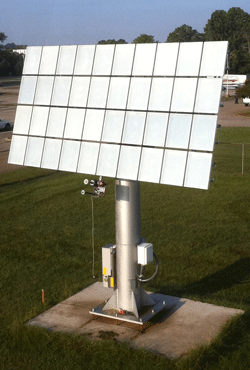- News
1 February 2012
CPV firm Semprius sets record 33.9% solar module efficiency
 Semprius Inc of Durham, NC, USA, which designs and makes high-concentration photovoltaic (HCPV) solar modules, has set a new record for photovoltaic module efficiency of 33.9% (active area). The latest prototype module was tested indoors under Standard Test Conditions (850W/m2, 25°C cell temperature, and a spectrum matched to AM1.5D) by the Instituto de Energía Solar at the Universidad Politécnica de Madrid (IES-UPM). Certified by IES-UPM and corroborated by outdoor measurements made at the Institute of Concentration Photovoltaic Systems (ISFOC) in Puertollano, Spain, the efficiency significantly exceeds the previous record of 32.0%.
Semprius Inc of Durham, NC, USA, which designs and makes high-concentration photovoltaic (HCPV) solar modules, has set a new record for photovoltaic module efficiency of 33.9% (active area). The latest prototype module was tested indoors under Standard Test Conditions (850W/m2, 25°C cell temperature, and a spectrum matched to AM1.5D) by the Instituto de Energía Solar at the Universidad Politécnica de Madrid (IES-UPM). Certified by IES-UPM and corroborated by outdoor measurements made at the Institute of Concentration Photovoltaic Systems (ISFOC) in Puertollano, Spain, the efficiency significantly exceeds the previous record of 32.0%.
“For the first time, we have been able to convert more than one-third of the sun’s energy into usable electricity,” says VP of technology Scott Burroughs. “This demonstrates how concentrated PV can leverage rapidly increasing efficiencies to continue driving down the cost of solar generated electricity,” he adds.
Picture: The latest prototype HCPV modules achieve 33.9% efficiency.
Developed with the support of the US Department of Energy’s National Renewable Energy Laboratory (NREL), Semprius’ HCPV modules use high-performance glass lenses to focus sunlight 1000-fold onto highly efficient triple-junction gallium arsenide-based microcells (600µm by 600µm in area and less than 10µm thick) that cover just 0.1% of the module area. The microcell’s small size enables the use of low-cost optics and electrical interconnects, which remove the heat, eliminating the need for costly thermal management solutions. In addition, Semprius grows its cell structures on top of a release layer so that they can be epitaxially lifted-off as part of its patented micro-transfer printing process, allowing it to reuse the GaAs substrate and hence cut costs dramatically. Semprius also uses an automated manufacturing process, leveraging standard manufacturing equipment and commodity materials, to reduce capital and labor costs.
“We looked carefully at each component of our module — cell, optics, enclosure and the manufacturing process — to develop a competitive solution that embodies high efficiency, performance and reliability,” says CEO Joe Carr. “Important to our customers is the fact that the module chosen for this third-party evaluation is part of the normal production distribution that will be commercially available later this year,” he adds.
Depending on the specific location and irradiation, the HCPV modules can deliver an energy output per square meter twice that of common polycrystalline silicon solar modules, it is reckoned. Leading module makers of conventional PV technologies achieve a maximum module efficiency of about 20% with monocrystalline PV modules and about 16% with polycrystalline technology.
In June 2011, Germany’s Siemens AG acquired a 16% stake in Semprius (as part of a $20m Series C round of venture capital funding), becoming a strategic partner with the aim of scaling up the HCPV technology to market maturity. “Semprius, as a leader in HCPV modules, shows us that we have bet on the right technology,” says Martin Pfund, CEO of the Siemens Energy Photovoltaic business unit. “Combined with our expertise in turnkey solutions business, it has the potential to become a game changer for the solar markets in regions with high irradiation,” he reckons. “With Semprius as a partner, we will further broaden our portfolio in the photovoltaics market.”
While Semprius will further develop its modules, Siemens is focusing its R&D activities on optimizing system components such as the trackers, field design and inverters (components for photovoltaic installations are part of Siemens’ Environmental Portfolio). Together with Semprius, Siemens aims to provide the best possible integrated solution.
The first full test installation has been operational in Arizona since August 2010, at UniSource Energy Corp subsidiary Tucson Electric Power (TEP) in Arizona as part of a joint development agreement signed in January 2010 between Semprius and Atlanta-based Siemens Industry Inc (the US affiliate of Siemens’ global Industry Sector business). Semprius is now ramping up global deployment of numerous demonstration systems at test sites around the world. “Our world record efficiency modules, combined with our low-cost manufacturing processes and Siemens’ PV system expertise, will deliver a best-in-class global solution for utility-scale solar plants,” reckons Carr.
Meanwhile, Semprius is completing construction of a pilot plant in Henderson, NC, to validate the technology for larger installations. Ramp up of the first commercial production of HCPV modules from the pilot line will begin in second-half 2012.
